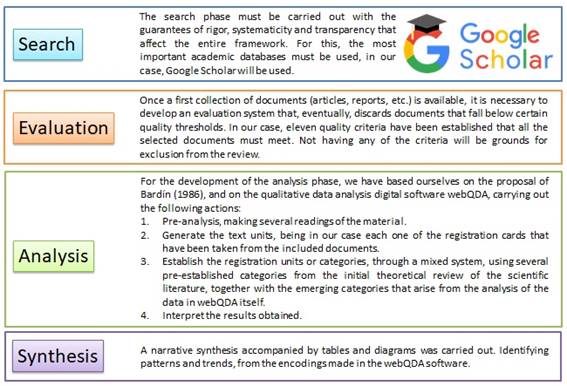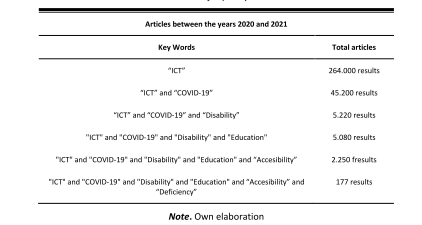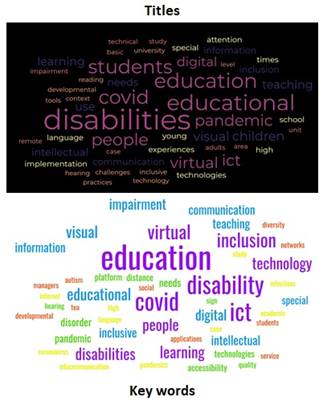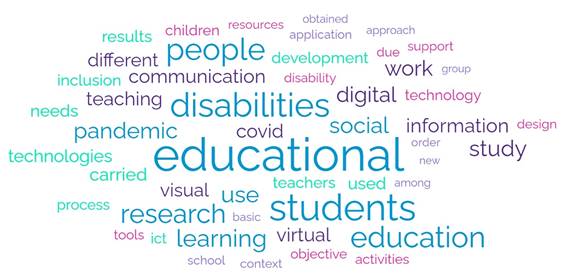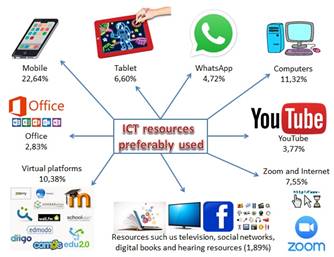1.Introduction
According to González (2021) the closure of educational centers, and, therefore, the cancellation of face-to-face educational activities as a consequence of COVID-19, has configured an educational scenario characterized by telematic teaching-learning practices (Menéndez & Figares, 2020). According to the United Nations Children's Fund (UNICEF), this situation has affected more than 10.3 million students in Spain and approximately 900,000 male and female teachers.
In accordance with Menéndez & Figares (2020), the educational community has not remained passive in the face of the sudden transformation of the educational context, rather the opposite. The different teaching teams have had to adapt in record time to the demands of the new educational format in which, among other activities, the traditional face-to-face classes, classroom interactions, group work or tutorials have had to be rethought. Therefore, we could say that more than before a stoppage of activity, we are facing a restructuring or adaptation of it. New Technologies, the collaboration of parents and the adaptability of education professionals have played a fundamental role in this transition process.
Electronic devices have served, for example, so that students and teachers can exchange didactic material in different formats, interact in virtual classrooms and that the different activities are monitored or evaluated. Parents have seen themselves in the shoes of teachers, having to participate in the learning process of their children in a more active way. Especially with the younger students. Teachers have fallen most of the responsibility, having to continue teaching while adapting to an educational context mediated by Information and Communication Technologies (ICT). It should be noted that as different studies suggest, teachers still do not feel fully prepared for this digital transformation (Miralles et al., 2019).
The problems that arose with these students and the consequences caused by COVID-19, such as the confinement to which the entire population has been forced, motivated the researchers to propose the research question: How has the use of ICT resources in people with disabilities and autism spectrum disorders been treated in the scientific literature during the pandemic? In addition, the research objective was raised: "Analyse the scientific production related to the use of ICT as a means to improve the teaching and learning process of people with disabilities and autism spectrum disorders during the pandemic". Our question and research objective are aligned with the need to deepen research on ICT and people with disabilities, due to the clear increase in their use in education and the difficulties that COVID-19 has caused in these people.
2. The use of the ICT during the pandemic
ICTs have been the main means to carry out the educational process efficiently during the period of confinement. Studies such as the one carried out by Arufe et al. (2020) shows that the television was the most present device in homes and the most used, reaching four times the time invested in it compared to other devices, according to the studies consulted because it is shared with the whole family, while the rest of the devices are for more individual use. Computers and tablets also played an important role, with computers being the second most common devices in homes and tablets the second most used by children during confinement. Adding the time dedicated to the different technological devices analysed in this work, the average use of ICTs was close to three hours a day. Cachón et al. (2020), carried out a systematic review of the literature on the use of digital devices in confinement, confirming excessive use of mobile phones in young people.
In agreement with the different public entities, they have offered a series of alternatives to support these educational sectors, for example, Burns (2020) and the United Nations Educational, Scientific and Cultural Organization (UNESCO) propose a series of four support alternatives in the face of this pandemic, this implies ensuring that all students have access to information technologies or radio and television modalities that are relevant in some contexts and that have been used successfully in crisis situations, such as the use of radio, television, mobile devices and online learning .
As Menéndez and Figares (2020) point out, during confinement, new technologies have allowed teachers and students to exchange didactic material and interact in virtual classrooms, allowing teachers to send, monitor and evaluate the proposed activities. Word processors and Internet search tools are shown as the most important components of digital competence (Cabanillas-García et al., 2020) and have been widely used during confinement. In addition, as there is a wide interaction of students, teachers, and families, it has been observed that there has been an improvement in the knowledge of ICT resources due to their constant use (Cabanillas-García et al., 2018; 2019). However, unequal availability and access to learning materials, lack of available ICT resources and problems of technological access or internet signal have been detected (Avello, 2020).
3. How the pandemic has affected people with disabilities
People with disabilities include those who face long-term physical, intellectual or sensory challenges that in interaction with various barriers can hinder their full and effective participation in society on equal terms with others (Leonardi et al. 2006). According to ECLAC (2020), people with disabilities were already among the most excluded in our societies before the COVID-19 pandemic and with the arrival of this health crisis and its devastating social and economic impacts; they will be among the most affected, together with their families, which will deepen their situation of exclusion and marginalization.
On the other hand, even with the same income level, households that have a person with a disability among their members must incur higher expenses due to the costs associated with health services, rehabilitation and specialized education, purchasing and maintenance of assistive devices, medications and transportation, among others. In addition, meeting the care needs of the person with a disability may force a member of the household, often a woman, to withdraw from the labor market, which affects the household income. When there are no support mechanisms to cover or subsidize these costs and needs, they must be paid for by the family, which can cause or aggravate situations of poverty (Comisión Económica para América Latina y el Caribe: CEPAL, 2019; 2020).
The research carried out by Peña et al. (2020) shows that the isolation conditions derived from COVID-19, this group requires greater adaptations and adjustments to achieve their educational inclusion in the face of the social and economic transformations that the pandemic has generated, and the gaps are accentuated or widened for this social group, since most of them were in conditions of exclusion, marginalization, and stigmatization before the pandemic. Mogollón et al. (2017) addresses that there are digital gaps in access to computers, the Internet, and skills in the use of these devices, as well as with virtual platforms, by people with disabilities. According to this researcher, new adaptations are needed for this virtual learning, but from more inclusive and integrative conceptions. Likewise, Flórez et al. (2016) argue that the reduction of this digital divide occurs from the design or adjustment of ICT, in order to achieve greater social inclusion and according to Delgado et al. (2021) it should be necessary to study both hardware and software technological tools, thus helping in communication processes, especially in special situations such as that caused by COVID-19.
Other reviews previously conducted sought to understand the impact of the COVID-19 pandemic on different groups of people with disabilities. A recent review describes the impacts on activities of daily living, such as decreased access to health care, changes in social and lifestyle habits, changes in mood, and decreased levels of health. physical activity. Trauma and stress within the disability community (Lebrasseur et al., 2021), including concerns about health care rationing and disability, isolation, and deaths and illnesses of loved ones and community members, were described as related to the pandemic (Lund et al., 2020), in addition to the expansion of problems and barriers faced by people with disabilities. These issues include dependence on the abuser for care and assistance, barriers to reporting abuse and seeking help, fear of retaliation, and other negative consequences (Lund et al., 2020). On the other hand, Santos and Cordeiro (2021) show that people with disabilities have been recognized as a risk group for COVID-19 by national and international health organizations, as well as organizations that fight for the rights of people with disabilities.
Finally, we can highlight that in the scientific literature it has been clearly identified that students with disabilities have suffered problems related to access to technological resources in order to continue their teaching and learning process efficiently. However, it is not clearly detected which groups have been most affected and in what way, an aspect that will be dealt with in our research.
4. Methodology
This section shows the research design used, the procedures carried out for the development of the research and the inclusion and exclusion criteria of the documents, together with the process of creation and validation of the category table to carry out the data analysis.
5.Research design
The design has been based on a bibliographic review and content analysis. This methodological proposal focuses on the field of social sciences and on qualitative and conceptual paradigm research. On the one hand, the bibliographic review relied on the ReSiste-CHS Framework model (Codina, 2018). This design is based on the performance of four processes for conducting a bibliographic review, which are: Search, evaluation, analysis and synthesis. The content analysis proposal elaborated by Bardín (1986) applying four fundamental steps in the analysis phase: Readings of the material, creation of the recording units, generating the recording units (categorization) and interpretation of the results.
6.Procedures
Figure 1 shows the procedures carried out for the development of the research.
Note. All the processes developed in the four phases of the investigation are described in the figure (Own elaboration).
7.Inclusion, exclusion and categorization criteria
A document review file was constructed that includes eleven analysis criteria: Title, abstract, keywords, number of authors, year of publication, type of methodology used, research design used, ICT resources preferably used, educational stage, disability treated, and most relevant conclusions obtained. The research carried out by Silva & Rodriguez (2018) for the creation of a document review file, linked to the analysis of the use of ICT in people with disabilities, has been taken as a reference.
The database used was Google Scholar, since it especially locates non-Anglo-Saxon literature and is mainly used in social science journals. In reference to the selection of the articles to be reviewed, a first selection was made according to the keywords: ICT, COVID-19, Disability, Education, Accessibility and Deficiency. Table 1 shows the first screening of articles using the keywords. 177 articles were obtained and analyzed.
Furthermore, 50 articles were selected that meet the inclusion criteria described below:
• Includes title, abstract, keywords, authors and year of publication.
• It clearly and descriptively reflects the type of methodology used.
• Shows and specifies the type of research design used.
• Defines the ICT resources preferably used
• Presents the educational stage treated
• Exposes the disability or deficiency treated through the use of technological resources
• The relevance of the conclusions obtained with the research is highlighted.
• They use reliable and scientifically verified sources of information.
• They are articles with free access.
• Aon original articles in Spanish, English and Portuguese.
• They are studies with a demonstrable scientific basis, and that provide real results carried out by people specialized in the field of study.
Articles that do not meet the criteria mentioned above or whose sources of information are unreliable or do not include clear, safe, and verified references have been discarded.
To perform content analysis, a category table was constructed and validated, according to the indications of Cisterna (2005), combining the following criteria in a visual table:
1. Creation of the categories and subcategories: A mixed model was used, being generated in an emergent or inductive way and in a deductive way from the analysis of the literature carried out (Diaz, 2018).
2. Research questions: Each of the questions that are formulated to obtain information about the subcategories (in a specific way) and the categories (in a general way).
3. Contents: These are individual units of significance that more accurately approximate the study analysis of the subcategory.
4. Objectives: These are the objectives that are intended to be met by obtaining information regarding the different contents.
To develop the validation of the category table, two subsequent data encoding were carried out, performed by different researchers, previously trained to carry it out in accordance with Cabanillas-García (2021) and Cabanillas-García et al. (2022), maintaining a difference between them less than 3% and with the original one less than 2%.
8.Results
First, the content of the titles and keywords of all documents was analysed. It can be seen in figure 2, that in the titles the key element is disability and, in the keywords, education. COVID-19 and ICT show the same impact in both sections, but aspects as important as accessibility or inclusion have a low impact.
In reference to the analysis of the summaries, it can be seen in figure 3 that a trend similar to that of the keywords is shown, with the difference that greater importance is given to teachers and the teaching and learning process that did not appear in the above items.
The articles have been written preferentially by one author (50%), followed by those written by more than three authors (23.91%) and finally those written by two or three authors (13.04%). Moreover, 60% of the articles have been published in 2021, compared to 40% published in 2020.
Analysing the methodology used in the articles, qualitative methodology has been used preferentially (51.02%) compared to those that use quantitative methodology, showing that they are used preferentially for this type of research, models that work on a small scale analysing the interaction of the subjects. To a lesser extent, mixed methodology and action research (8.16%) and other types of methodologies (4.08%) have been used. Regarding the research design used, descriptive designs (44.14%), bibliographic reviews (17.78%) and content analysis (11.11%) have been used as a priority.
Regarding the analysis of ICT resources used most frequently for teaching and learning processes with disabled people, it can be seen in the figure 4 that the most used have been mobile phones (22.64%), followed by computers (11.32%) and virtual platforms (10.38%). ICT resources have been used much more for communication purposes than as a collaborative element to improve the teaching and learning process in students with disabilities.
On the other hand, the largest volume of articles has been aimed at the educational stage of primary education (34.38%) and adults (31.25%), followed by the secondary stage and high school (23.44%). A very low volume of publications aimed at the stage of early childhood education stands out (10.94%). In the analysis of the disability treated in the articles, it has been observed that sensory disability is mainly treated (34.78%), followed by intellectual disability (21.34%). Further away, psychic disability is located (17.39%), highlighting in a general way the treatment of Autism Spectrum Disorder (ASD) within these publications. The least treated were physical or motor disability (13.04%), attention deficit (8.70%) and multiple disorders (4.35%).
Focusing on the main conclusions obtained in the articles, it has been observed that in the relationship between ICTs and disabled people, it is necessary to ensure the conditions of access to ICTs (33.93%) since due to the confinement of the elderly population school, many population centres did not have devices with Internet access to work or very low connectivity, being increased in the population with disabilities. On the other hand, it is also highlighted that ICTs improve the academic performance (32.14%) of this type of student, in particular the group with sensory disabilities, with a wide variety of applications and resources available to use. Similarly, it has been observed that there is a great deficiency in the use of ICT in people with some type of disability (16.07%) derived from various factors such as the lack of teacher training in two aspects: digital competence and knowledge in depth of the deficiencies, to know how to work with these students from a distance. It should be noted that there has been a very low appearance of ICTs improving motivation in these students (3.57%).
Regarding the analysis of educational inclusion in the period of the pandemic, it is clearly highlighted that this aspect is improved with the use of ICT (60.71%), since it helps in many key aspects of each of the deficiencies analysed. On the other hand, it is also highlighted that families are a fundamental and indispensable support for inclusion (14.29%) allowing them to give support to their children and in many cases maintaining communication with the teaching staff to be able to develop the teaching activity during the period of confinement. It has also been observed that there is no interaction between students who have a disability and those who do not (10.71%), which means that they cannot relate to their peers and only do so with their family environment, complicating their stability emotional.
Finally, in relation to the most relevant conclusions about the school environment, it has been found that most of the documents show low training in knowledge and use of ICT resources (34.78%) that makes it very difficult to carry out activities suitable for working with disabled people. On the other hand, a high percentage show that there are deficiencies in educational support systems (21.74%), which have increased with the appearance of COVID-19, while teachers need to identify which are the best resources to be able to use with each type of impairment (17.39%).
9.Discussion and conclusions
Answering our research question: How has the use of ICT resources influenced people with disabilities and autism spectrum disorders have been treated in the scientific literature during the pandemic? and the objective: "Analyze the scientific production related to the use of ICT as a means to improve the teaching and learning process of people with disabilities and autism spectrum disorders during the pandemic" it has been verified that most of The scientific literature analyzed is written by a single author, generally belonging to doctoral theses. On the other hand, a qualitative methodology has been used preferentially, since according to Guerrero (2016) there is in its greater freedom and flexibility of adaptation due to the results that can be obtained, which adapts to the widely changing reality caused by COVID-19. Similarly, in general descriptive designs have been used.
The main ICT resources used have been mobile phones, computers, and virtual platforms, with different results from those shown by Arufe et al. (2020) where the television was the most present device in homes and also the most used, but they coincide with those of Cachón et al. (2020) showing intensive mobile phone use during confinement. It has been possible to confirm that there is a broad agreement among the reviewed publications, in which the conditions of access to ICTs by this group must be guaranteed, since according to Burns (2020) not all the child population has been able to develop efficiently their learning, due to lack of ICT resources or access to technology or the Internet. And the results coincide with Peña et al. (2020) in which due to the isolation conditions derived from Covid-19, this group requires further adaptations and adjustments to achieve their educational inclusion in the face of the social and economic transformations that the pandemic has generated, and the gaps are accentuated or widened for this social group. On the other hand, there is a clear agreement that educational inclusion in the period of the pandemic is improved with the use of ICT, since according to Flórez et al. (2016), managing to reduce the digital divide through the design or adjustment of ICT, will achieve greater social inclusion, especially of students with sensory and mental deficiencies such as students with ASD or those who have an attention deficit.
Finally, it should be noted that both teachers and families have been the main agents involved in the teaching and learning process of students. However, the results coincide with Miralles et al. (2019) in which teachers still do not feel fully prepared for this digital transformation. Likewise, a clear deficiency in educational support has been observed, preferably in students with sensory and psychological disabilities and we agree with ECLAC (2019) that there are no support mechanisms to cover or subsidize the costs and needs caused by COVID- 19, which must be paid for by the family, which can cause or aggravate situations of poverty.
In the future, it is convenient to delve into the disabilities that have shown less appearance in the scientific literature, creating new programs and projects that help improve their learning capacity with the use of ICT resources, taking as a reference, those that have been seen to be the most used. Similarly, research should be considered in the future that compares our results obtained with those of other databases such as Web of Science, Scopus or Eric. As the main limitation of our study, it should be noted that scientific production in times of pandemic has grown exponentially, however, a large number of publications have not met the necessary criteria of scientific rigor and quality.
This research was financed by the European Regional Development Fund and the Extremadura Autonomous Government. GR18115 project, together with the CiberDidact Research Group that supported the research (figure 5).














